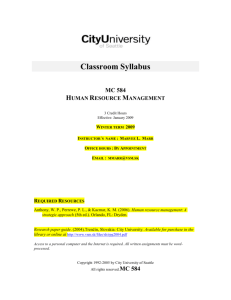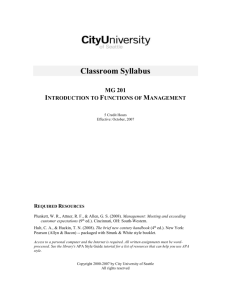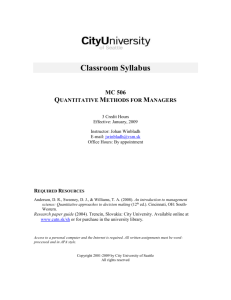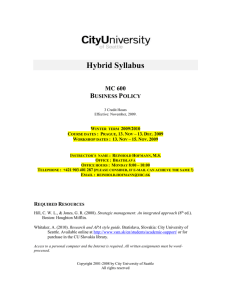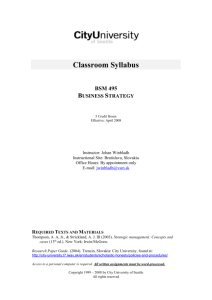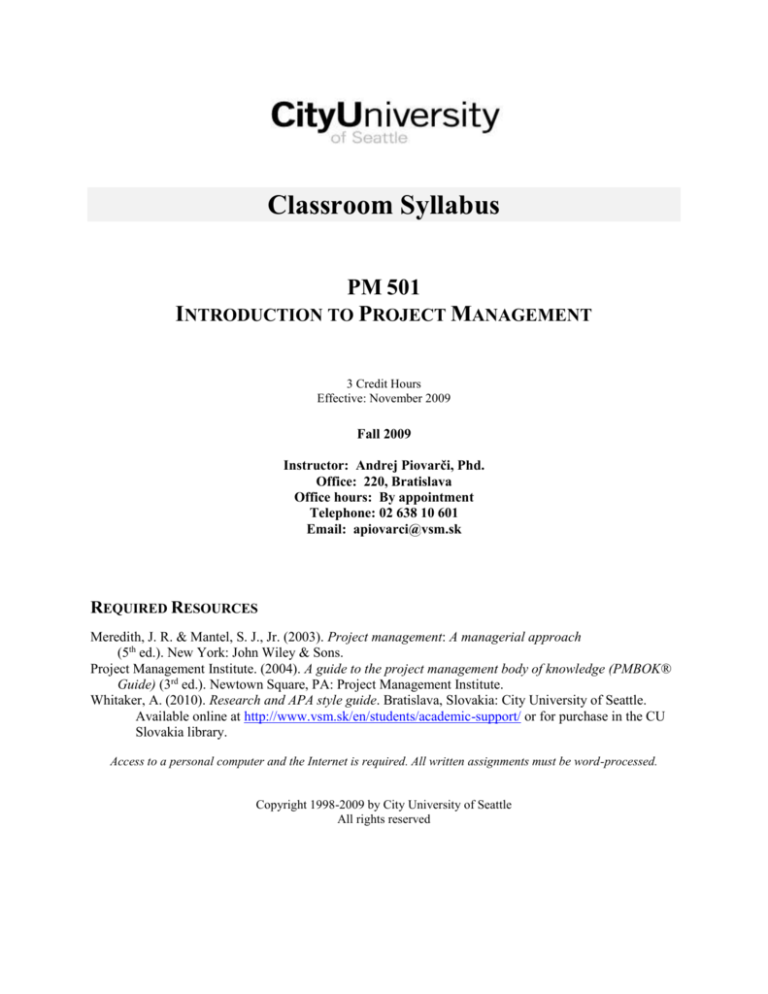
Classroom Syllabus
PM 501
INTRODUCTION TO PROJECT MANAGEMENT
3 Credit Hours
Effective: November 2009
Fall 2009
Instructor: Andrej Piovarči, Phd.
Office: 220, Bratislava
Office hours: By appointment
Telephone: 02 638 10 601
Email: apiovarci@vsm.sk
REQUIRED RESOURCES
Meredith, J. R. & Mantel, S. J., Jr. (2003). Project management: A managerial approach
(5th ed.). New York: John Wiley & Sons.
Project Management Institute. (2004). A guide to the project management body of knowledge (PMBOK®
Guide) (3rd ed.). Newtown Square, PA: Project Management Institute.
Whitaker, A. (2010). Research and APA style guide. Bratislava, Slovakia: City University of Seattle.
Available online at http://www.vsm.sk/en/students/academic-support/ or for purchase in the CU
Slovakia library.
Access to a personal computer and the Internet is required. All written assignments must be word-processed.
Copyright 1998-2009 by City University of Seattle
All rights reserved
PM 501
INTRODUCTION TO PROJECT MANAGEMENT
This document provides an overview of the course foundation elements, assignments, schedules, and
activities. For information about general City University of Seattle policies, please see the City University
of Seattle catalog. If you have additional questions about the course, please contact your instructor.
Notification to Students with Disabilities
If you are a student with a disability and you require certain help, please contact the site administrator as
soon as possible.
Scholastic Honesty
City University of Seattle expects each student to do his/her own work. The University has "zero
tolerance" for cheating, plagiarism, unauthorized collaboration on assignments and papers, using "notes"
during exams, submitting someone else's work as one's own, submitting work previously submitted for
another course, or facilitating acts of academic dishonesty by others. The penalties are severe! A first
offense can result in a zero grade for the course and suspension for one quarter; a second offense can
result in a zero grade for the course and suspension for two or more quarters; a third offense can result in
expulsion from the University. The Policy and Procedures may be found at
http://www.vsm.sk/en/students/scholastic-honesty/policies-and-procedures/.
In addition to providing your work to the instructor for grading, you must also submit an electronic copy
for the CU archives (unless the work is specifically exempted by the instructor). You will not receive a
grade for particular work until and unless you submit this electronic copy. The procedure for submitting
work to the archives is to upload it via the website http://www.vsm.sk/en/students/on-linecenter/uploader/uploader.html. Files should include the cover page of the work with the student name,
instructor name, course name and number, and date. File names should indicate the type of assignment,
such as “researchpaper.doc”, “casestudy.doc” or “ thesis.doc” (student name should not be a part of the
file name because the system adds it). All files received into the archives are submitted to
www.TurnItIn.com for plagiarism checking.
COURSE DESCRIPTION
This course introduces specific managerial concepts and techniques useful in project management. Topics
include the following: organizational structure; how to plan, begin, carry out, control, and close project
processes; and the relationship between projects and an organization’s mission, objectives and goals.
PM501
SYL Page 2
Eff: 11/09
LEARNING GOALS
Upon the successful completion of this course, you will be able to:
Understand how projects and project management to the various functions of an organizational
“enterprise”;
Assess project feasibility and project plan completeness, procedures, and techniques;
Apply basic project management concepts to business situations, including the “project life cycle.”
CORE CONCEPTS
To achieve the goals of this course, you will need to master the following core concepts:
1. Basics of project selection;
2. Characteristics of a successful project manager;
3. Basic project organization;
4. Planning techniques;
5. Conflict resolution;
6. Negotiation techniques;
7. Project budgeting;
8. Cost estimating;
9. Project scheduling fundamentals;
10. Resource leveling;
11. Loading approaches;
12. Monitoring;
13. Information systems basics;
14. Project control;
15. Risk management fundamentals;
16. Project auditing;
17. Termination techniques;
18. International projects;
19. Cultural differences overview;
20. Modern developments;
21. The future of project management overview.
PM501
SYL Page 3
Eff: 11/09
PROGRAM OVERVIEW
Project Management is growing rapidly as both an occupation and as an academic discipline. It is based
on a comprehensive and pragmatic approach to management that focuses on the successful achievement
of defined deliverables. Project Management is the embodiment of quality management and has already
become the predominant management approach in fields such as construction, engineering, performing
arts production, technology development, and telecommunications.
RECOMMENDED SUPPLEMENTARY RESOURCES
As a City University of Seattle student, you have access to library resources regardless of where and how you are
taking this class. To access the resources necessary to complete your coursework, visit the library menu in the
My.CityU portal at https://my.cityu.edu, and the CU Slovakia library home page at http://library.cutn.sk/.
A good place to begin your research is through the management program resources page in the My.CityU library.
It provides links to relevant journals, books, and Web sites. Search the online databases for journal, magazine, and
newspaper articles. For additional help, visit the Slovakia library or submit your question in the Contact Us section
of the Slovakia library’s web site.
OVERVIEW OF COURSE ACTIVITIES AND GRADING
The grade you receive for the course will be derived using City University of Seattle’s decimal grading
system, based on the following:
Overview of Required Assignments
Participation and Assignments
Individual Case Analysis
Individual Project Management Assessment
Team Project
Presentation
Final Examination
TOTAL
% of Final Grade
10 %
20 %
20 %
20 %
10 %
20 %
100 %
Please see the current City University of Seattle catalog or consult your instructor for guidance in
determining your decimal grade.
EXPLANATION OF ASSIGNMENTS AND GRADING
PARTICIPATION AND ASSIGNMENTS
Whether in class, online, or in a mixed mode setting, students will be graded on their participation in
classroom discussions; their ability to present, explain, or defend alternative viewpoints; and the degree to
which they have mastered the concepts and principles inherent in the study of Project Management at this
course level. The instructor will provide specific instructions for in-class participation, discussions and
assignments.
PM501
SYL Page 4
Eff: 11/09
INDIVIDUAL CASE ANALYSIS
Each student will provide an analysis for the application of project management principles during the
construction of the Denver International Airport (DIA). The Denver International Airport Case Study is
taken from the book Project Management Case Studies, Second Edition by Dr. Harold Kerzner, PhD,
2006, John Wiley & Sons Inc.
For this analysis, the student will address the case from a lessons learned perspective (i.e the airport is
already built) and focus on the project management issues of the case. The following case study format is
required for this analysis.
Problem Statement: A brief statement indicating the root cause of problems or symptoms. The root
cause is the issue/situation from which all problems result. All reports for this class should address the
correct application of project management tools.
Justification of Problem Statement: This is a justification of why you chose the problem statement you
did. You should use facts from the case to substantiate your problem statement.
Possible Alternatives: The alternatives should address the problem you identified. (Remember this must
be related to project management principles.) This is a brief listing of alternative courses of action (or
what should have been done in a lessons learned case)
Evaluation of alternatives: For each alternative selected, discuss the pros and cons as they relate to
solving the problem you identified. Some people will do a SWOT analysis for each alternative and relate
them to the problem statement. I am happy with a listing of pros and cons relative to project management.
Recommendation/Conclusion: From your alternatives and the evaluation, there will be one or more
alternatives that stand out as the best course of action to solve the problem identified above. This should
be your conclusion. The conclusion should be justified by previous comments in the report (i.e. the
logically supported conclusion).
Implementation and follow on steps:. A brief discussion on how the student would implement the
concluding statement if they were assigned a large project such as this.
A good question to ask as you evaluate your case is, "As a project manager, what can I learn from this
case that will help me be more effective?"
Each paper submitted is expected to be approximately 5-7 pages in length with a discussion of proper
application of project management principles. Papers should be prepared in 10-12 pt font, and doublespaced. A title page consisting of the project title, your name, e-mail, date, and course is required for all
assignments.
The following are questions that help focus attention on correct project management principles. These
questions are provided as a guide and specific answers are not required in your report.
1. What are the basic problems to be solved with this case?
2. What are the strengths, weaknesses, opportunities, and threats of the case? (a SWOT analysis)
PM501
SYL Page 5
Eff: 11/09
3. Who are the stakeholders and what are their interests or objectives?
4. Did the airlines support the decision to build DIA?
5. Why was United opposed to expansion at Front Range Airport?
6. Why was the new baggage handling system so important to United?
7. Is DIA a good strategic fit for Continental?
8. What appears to be the single greatest risk in the decision to build DIA?
9. What is the function of the project management team and why were two companies involved?
10. When did the effectiveness of the project management team begin to be questioned?
11. Did it sound as though the statement of work/specifications provided by the city to the PMT were
"vague" for the design phase?
12. During the design phase, contractors were submitting re-estimates for work, 30 days after the
original estimates, and the new estimates were up to $50 million larger than the prior estimate.
Does this reflect upon the capabilities of the Project Management Team (PMT)?
13. Should the PMT be qualified to perform risk analysis?
14. Why were the architects coordinating changes at the construction site? Should the PMT have
been replaced?
15. Do scope changes reflect upon the ineffectiveness of a project management team?
16. Why did United Airlines decide to act as the project manager for the baggage handling system on
Concourse B?
Grading Criteria for Individual Case Analysis
Integration of course concepts
Completeness of analysis
Logically supported conclusions, recommendations
Bibliographic support
Proper grammar, spelling, punctuation, and syntax
25%
30%
25%
10%
10%
TOTAL
100%
INDIVIDUAL PAPER: PROJECT MANAGEMENT ASSESSMENT
Project Management opportunities are all around us. The purpose of this assignment is to give students a
chance to observe what they have learned by evaluating a project familiar to them. Each student is to
identify a project (either past or present) in their workplace or community. Some examples would be
local road improvement projects, construction of public buildings, community events, fund raisers,
PM501
SYL Page 6
Eff: 11/09
planning significant celebrations for holidays or special occasions, etc. There are many opportunities to
observe project management in practice. Written papers summarize the project and provide an individual
observation of how well the project is progressing. In the case of past projects, identify what worked
well and improvement opportunities that were observed. Each paper should be 3-5 pages in length. All
assignments require a cover page and bibliography.
Grading Criteria for Individual Paper: Project Management Assessment
Description of the situation
Original presentation of lessons learned
Logically supported conclusions, recommendations
Bibliographic support
Proper grammar, spelling, punctuation, and syntax
20%
35%
25%
10%
10%
TOTAL
100%
TEAM PROJECT: APPLYING PROJECT MANAGEMENT PRINCIPLES
This assignment is a team effort. There are multiple project activities. The purpose of this assignment is
to give the student practice in creating a project plan and to experience the virtual organization. The team
will develop the project theme (title) and deliver standard parts of project planning (see deliverables
below).
To successfully complete this assignment, teams will be established with 3-4 team members. The
outcome will be a word document. A title page consisting of the project title, names and e-mails of team
members, date, and course is expected. The following deliverables are required for this exercise. Scoring
is as indicated for each deliverable.
Grading Criteria for Team Project: Applying Project Management Principles
DELIVERABLE
POINTS
Team Name
Written Charter
Initial Scope Statement
Work Breakdown Structure
Network with Critical Path defined
Schedule with Resource Allocation
Project Budget
Identified Risks with mitigation activities
Method of Controlling Scope Growth and Changes
Method of assuring Customer satisfaction
5%
10%
10%
15%
10%
10%
10%
10%
10%
10%
TOTAL
100%
PM501
SYL Page 7
Eff: 11/09
PRESENTATION
You will make a presentation for the class. The presentation explains main arguments of one of your
papers and especially your conclusions. It will last 7 minutes and a discussion with the class and teacher
will follow. You should try to present the paper in an interesting way and focus especially on conclusions
and lessons learned.
Grading Criteria for Presentation
Logically supported conclusions
Original lessons learned
Integration of course concepts
Proper organization and logical flow of presentation
Verbal and non-verbal communication
40 %
20 %
20 %
20 %
20 %
TOTAL
100%
FINAL EXAMINATION
You should be prepared to answer a variety of types of questions pertinent to the concepts covered in or
suggested by the course materials and assignments. Your instructor may provide you with additional
information regarding the content and style of exam in this course.
Grading Criteria for Essay Questions on Examination
Clear grasp of major issues posed by the question
Valid arguments and appropriate supportive detail
Appropriate analysis, evaluation, and synthesis
Demonstrated ability to employ terms, concepts, and frames of
reference from texts and other course materials
Proper organization and logical flow of responses
20%
20%
20%
20%
TOTAL
100%
PM501
SYL Page 8
Eff: 11/09
20%
Recommended Course Schedule
The schedule for course activities and assignments is below. If you find you are unable to complete the
assignments as scheduled, contact your instructor. Your instructor may elect to adjust the outline to meet
the unique needs of the class.
SESSION
1
November 21
2
November 22
3
TOPICS AND ASSIGNMENTS
READINGS
Projects in Contemporary Organizations
The Project Manager
Project Organization
Defining the Project
Meredith, Chapter 1,
3 & 4;
PMBOK® Guide
Chapter 1
Project Planning
Conflict and Negotiation
Budgeting and Cost Estimation
Scheduling
The Planning Process
Meredith, Chapters 5
– 8;
Resource Allocation
Critical Chain
Meredith, Chapter 9;
Monitoring and Information Systems
Project Control
Controlling the Project
DUE: Individual Case Analysis (December 11)
DUE: Team Project (December 11)
Meredith, Chapters
10–11;
November 28
4
November 29
5
December 12
6
December 13
Project Auditing
Project Termination
Advancing Your Practice of Project Management
DUE: Presentation
Presentations
Final Exam Review
DUE: Presentation
DUE: Individual Project Management Assessment
(December 15)
Final Examination (December 18)
PM501
SYL Page 9
Eff: 11/09
Meredith, Chapter
12 & 13;

